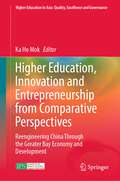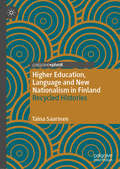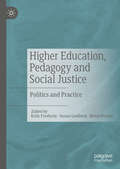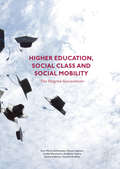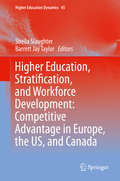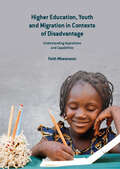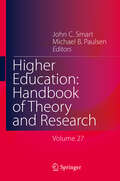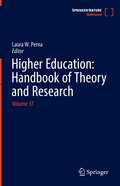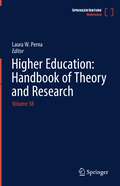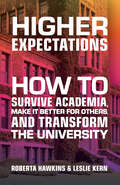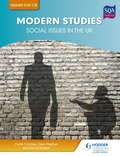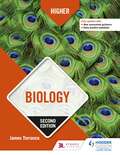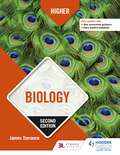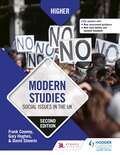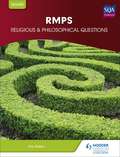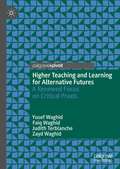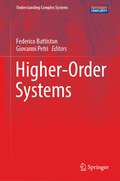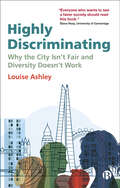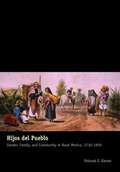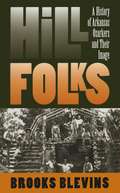- Table View
- List View
Higher Education, Innovation and Entrepreneurship from Comparative Perspectives: Reengineering China Through the Greater Bay Economy and Development (Higher Education in Asia: Quality, Excellence and Governance)
by Ka Ho MokThis book analyzes how universities in the Greater Bay Area in South China could work together for promoting innovation-centric entrepreneurship, research and knowledge transfer, as well as establishing a leading higher education hub in China mainland. This book brings together leading scholars from history, higher education, sociology, city and urbanism, and development studies, to analyzing the role of higher education, entrepreneurship, and talent hub from historical, comparative, and international perspectives. This book also shares different development experiences of Tokyo, Florida, and New York Bay economies and how higher education has supported their success stories.
Higher Education, Language and New Nationalism in Finland: Recycled Histories
by Taina SaarinenThe book discusses recycled discourses of language and nationalism in Finnish higher education, demonstrating the need to look beyond language in the study of language policies of higher education. It analyses the historical and political layeredness of language policies as well as the intertwined nature of national and international developments in understanding new nationalism. Finnish higher education language policies were fuelled by the dynamics and tensions between the national languages Finnish and Swedish until the 2000s, when English begins to catalyse post nationalist discourses of economy and competitiveness. In the 2010s, English begins to be seen as a threat to Finnish. Educational, economic and epistemic nationalism emerge as the main cycles of new nationalist language policies in Finnish higher education. The book will be of interest to language policy and higher education scholars and practitioners, as well as graduate students language policy and higher education.
Higher Education, Pedagogy and Social Justice: Politics and Practice
by Helen Proctor Susan Goodwin Kelly FreebodyThis book explores how the concepts of social justice, diversity, equity and inclusion can be understood within the context of higher education. While terms such as these are often in common use in universities, they are not always used with clarity and precision. The editors and contributors offer a serious and detailed examination of pressing contemporary concerns around ‘social justice’ across politics, practice and pedagogy in order to encourage hard thinking and practical agenda setting for social-justice oriented research, teaching and community engagement. Drawing upon new theoretical work, research projects and innovative university teaching, this book offers both useful theoretical insights and practical possibilities for action. This collective and collaborative volume will be of interest and value to all those interested in promoting social justice, in particular how it can be promoted within the university setting.
Higher Education, Social Class and Social Mobility
by Harriet Bradley Ann-Marie Bathmaker Nicola Ingram Jessie Abrahams Anthony Hoare Richard WallerThis book explores higher education, social class and social mobility from the point of view of those most intimately involved: the undergraduate students. It is based on a project which followed a cohort of young undergraduate students at Bristol's two universities in the UK through from their first year of study for the following three years, when most of them were about to enter the labour market or further study. The students were paired by university, by subject of study and by class background, so that the fortunes of middle-class and working-class students could be compared. Narrative data gathered over three years are located in the context of a hierarchical and stratified higher education system, in order to consider the potential of higher education as a vehicle of social mobility.
Higher Education, Stratification, and Workforce Development
by Sheila Slaughter Barrett Jay TaylorThis work analyses how political economic shifts contribute to competition within higher education systems in the US, EU, and Canada. The authors highlight competition for prestige and public and private subsidies, exploring the consequences of these processes through theoretical and empirical analyses. Accordingly, the work highlights topics that will be of interest to a wide range of audiences. Concepts addressed include stratification, privatization of formerly public subsidies, preference for "high tech" academic fields, and the vocationalization of the curriculum (i. e. , Science, Technology, Engineering and Mathematics: [STEM] fields, selected professions, and business) rather than the liberal arts or the Humboldtian vision of the university. Across national contexts and analytic methods, authors analyze the growth of national policies that see universities as a sub set of economic development, casting universities as corporate research laboratories and education as central to job creation. Throughout the volume, the authors make the case that national and regional approaches to politics and markets result in different experiences of consequences of academic capitalism. While these shifts serve the interests of some institutions, others find themselves struggling to meet ever-greater expectations with stagnant or shrinking resource bases.
Higher Education, Youth and Migration in Contexts of Disadvantage: Understanding Aspirations and Capabilities
by Faith MkwananziThis book explores the lives, experiences and the formation of higher educational aspirations among marginalised migrant youth in South Africa. Using a case study based in Johannesburg, the author illuminates their voices in order to demonstrate the reality faced by these young people in the context of migration to the Global South. Within the complex landscape of global and African migration, this book draws on detailed narratives to understand the conditions under which aspirations for higher education are – or are not – developed. In doing so, the author highlights the value of understanding individual lives, experiences and opportunities from a human development point of view, capturing the multidimensional disadvantages experienced by migrants in a balanced, intersectional manner. Balancing empirical data with theoretical analysis, this volume tells a rich, nuanced story about marginalised migrant youth – an essential work for understanding the conditions necessary for such youth to live valuable lives in both local and international contexts. This book will appeal to students and scholars of youth migration, aspiration and educational opportunities, particularly within the Global South.
Higher Education: Handbook of Theory and Research
by John C. Smart Michael B. PaulsenPublished annually since 1985, the Handbook series provides a compendium of thorough and integrative literature reviews on a diverse array of topics of interest to the higher education scholarly and policy communities. Each chapter provides a comprehensive review of research findings on a selected topic, critiques the research literature in terms of its conceptual and methodological rigor, and sets forth an agenda for future research intended to advance knowledge on the chosen topic. The Handbook focuses on twelve general areas that encompass the salient dimensions of scholarly and policy inquiries undertaken in the international higher education community. The series is fortunate to have attracted annual contributions from distinguished scholars throughout the world.
Higher Education: Volume 37 (Higher Education: Handbook of Theory and Research #37)
by Laura W. PernaPublished annually since 1985, the Handbook series provides a compendium of thorough and integrative literature reviews on a diverse array of topics of interest to the higher education scholarly and policy communities. Each chapter provides a comprehensive review of research findings on a selected topic, critiques the research literature in terms of its conceptual and methodological rigor and sets forth an agenda for future research intended to advance knowledge on the chosen topic. The Handbook focuses on a comprehensive set of central areas of study in higher education that encompasses the salient dimensions of scholarly and policy inquiries undertaken in the international higher education community. Each annual volume contains chapters on current important issues pertaining to college students and faculty, organization and administration, curriculum and instruction, policy, diversity issues, economics and finance, history and philosophy, community colleges, advances in research methodology and other key aspects of higher education administration. The series is fortunate to have attracted annual contributions from distinguished scholars throughout the world.
Higher Education: Volume 38 (Higher Education: Handbook of Theory and Research #38)
by Laura W. PernaPublished annually since 1985, the Handbook series provides a compendium of thorough and integrative literature reviews on a diverse array of topics of interest to the higher education scholarly and policy communities. Each chapter provides a comprehensive review of research findings on a selected topic, critiques the research literature in terms of its conceptual and methodological rigor and sets forth an agenda for future research intended to advance knowledge on the chosen topic. The Handbook focuses on a comprehensive set of central areas of study in higher education that encompasses the salient dimensions of scholarly and policy inquiries undertaken in the international higher education community. Each annual volume contains chapters on current important issues pertaining to college students and faculty, organization and administration, curriculum and instruction, policy, diversity issues, economics and finance, history and philosophy, community colleges, advances in research methodology and other key aspects of higher education administration. The series is fortunate to have attracted annual contributions from distinguished scholars throughout the world.
Higher Expectations: Can Colleges Teach Students What They Need to Know in the 21st Century?
by Derek BokHow our colleges and universities can respond to the changing hopes and needs of societyIn recent decades, cognitive psychologists have cast new light on human development and given colleges new possibilities for helping students acquire skills and qualities that will enhance their lives and increase their contributions to society. In this landmark book, Derek Bok explores how colleges can reap the benefits of these discoveries and create a more robust undergraduate curriculum for the twenty-first century.Prior to this century, most psychologists thought that creativity, empathy, resilience, conscientiousness, and most personality traits were largely fixed by early childhood. What researchers have now discovered is that virtually all of these qualities continue to change through early adulthood and often well beyond. Such findings suggest that educators may be able to do much more than was previously thought possible to teach students to develop these important characteristics and thereby enable them to flourish in later life.How prepared are educators to cultivate these qualities of mind and behavior? What do they need to learn to capitalize on the possibilities? Will college faculties embrace these opportunities and make the necessary changes in their curricula and teaching methods? What can be done to hasten the process of innovation and application? In providing answers to these questions, Bok identifies the hurdles to institutional change, proposes sensible reforms, and demonstrates how our colleges can help students lead more successful, productive, and meaningful lives.
Higher Expectations: How to Survive Academia, Make it Better for Others, and Transform the University
by Leslie Kern Roberta HawkinsHigher Expectations is a practical guide to navigating academia for people who want to improve their own day-to-day work lives and create better conditions for everyone. Universities are broken: they’re built on systems that are discriminatory, hierarchical, and individualistic. This hurts the people that work and learn in them and limits the potential for universities to contribute to a better world. But we can raise our expectations. Hawkins and Kern envision a university transformed by collaboration, care, equity, justice, and multiple knowledges. Drawing on real-world, international examples where people and institutions are already doing things in new ways, Higher Expectations offers concrete advice on how to make these transformations real. It covers many areas of academic life including course design, conferencing, administration, research teams, managing workloads and more. Designed for faculty, graduate students, postdoctoral researchers, and other scholars, Higher Expectations delivers hope and practical actions you can take to start making change now. It is a must-have for everyone working in academia today.
Higher Modern Studies for CfE: Social Issues in the UK
by Gary Hughes Frank Cooney David SheerinWritten specifically to match the Higher for CfE syllabus offered by the Scottish Qualifications Authority for examination from 2015 onwards, Social Issues in the UK covers the two issues that students have the opportunity to study in this unit of the course: Social Inequality and Crime and the Law.· Questions to help monitor progress throughout the topics· Case studies and fact files to focus attention on specific areas· Assessment guidance to prepare students for the final exam
Higher Modern Studies: Democracy in Scotland and the UK: Second Edition
by Gary Hughes Frank Cooney David SheerinExam Board: SQALevel: HigherSubject: Modern StudiesFirst Teaching: August 2018First Exam: June 2019A course textbook covering the most recent political developments and fully updated to take on board the latest SQA course assessment changes. Written specifically to match the Higher syllabus offered by the Scottish Qualifications Authority, Democracy in Scotland and the UK covers all of the topics that students will encounter in this unit of the course: UK constitutional arrangements, representative democracy and the political process, electoral systems and voting behaviour. - Questions to help monitor progress throughout the topics - Case studies and fact files to focus attention on specific areas - Assessment guides to prepare students for the final exam
Higher Modern Studies: Democracy in Scotland and the UK: Second Edition
by Gary Hughes Frank Cooney David SheerinExam Board: SQALevel: HigherSubject: Modern StudiesFirst Teaching: August 2018First Exam: June 2019A course textbook covering the most recent political developments and fully updated to take on board the latest SQA course assessment changes. Written specifically to match the Higher syllabus offered by the Scottish Qualifications Authority, Democracy in Scotland and the UK covers all of the topics that students will encounter in this unit of the course: UK constitutional arrangements, representative democracy and the political process, electoral systems and voting behaviour. - Questions to help monitor progress throughout the topics - Case studies and fact files to focus attention on specific areas - Assessment guides to prepare students for the final exam
Higher Modern Studies: International Issues, Second Edition
by Gary Hughes Frank Cooney Pauline Kelly Steph O'ReillyExam Board: SQA Level: Higher Subject: Modern Studies First Teaching: August 2018 First Exam: June 2019 Updated specifically to match the SQA Higher Modern Studies syllabus for examination from 2019 onwards.International Issues covers three of the world powers that students may choose to study in this unit of the course (the United States of America, the Republic of South Africa and the People's Republic of China), along with Development Issues in Africa and Global Security.
Higher Modern Studies: International Issues, Second Edition
by Gary Hughes Frank Cooney Pauline Kelly Steph O'ReillyExam Board: SQA Level: Higher Subject: Modern Studies First Teaching: August 2018 First Exam: June 2019 Updated specifically to match the SQA Higher Modern Studies syllabus for examination from 2019 onwards.International Issues covers three of the world powers that students may choose to study in this unit of the course (the United States of America, the Republic of South Africa and the People's Republic of China), along with Development Issues in Africa and Global Security.
Higher Modern Studies: Social Issues in the UK, Second Edition
by Gary Hughes Frank Cooney David SheerinExam Board: SQA Level: Higher Subject: Modern Studies First Teaching: August 2018 First Exam: June 2019 Updated specifically to match the SQA Higher syllabus for examination from 2019 onwards, this textbook covers the two issues that students have the opportunity to study in this section of the course: Social Inequality and Crime and the Law. · Questions to help monitor progress throughout the topics · Case studies and fact files to focus attention on specific areas · Assessment guidance to prepare students for the final exam
Higher Modern Studies: Social Issues in the UK: Second Edition
by Gary Hughes Frank Cooney David SheerinExam Board: SQA Level: Higher Subject: Modern Studies First Teaching: August 2018 First Exam: June 2019 Updated specifically to match the SQA Higher syllabus for examination from 2019 onwards, this textbook covers the two issues that students have the opportunity to study in this section of the course: Social Inequality and Crime and the Law. · Questions to help monitor progress throughout the topics · Case studies and fact files to focus attention on specific areas · Assessment guidance to prepare students for the final exam
Higher RMPS: Religious & Philosophical Questions
by Joe WalkerThe only resource for religious and philosophical questions at Higher level, by a bestselling author and expert in the field.Joe Walker's new full colour book provides comprehensive coverage of the newly designed CFE Higher in Religious, Moral and Philosophical Studies, but is also ideal for students across Scotland studying key topic areas in Religious and Philosophical Questions as part of the broad general education and the senior phase of RME. The book:Offers a lively, accessible and engaging style with appropriate humour that reflects real-life situations and moral issuesHighlights the importance of dealing with varieties of belief within religious traditionsDeals with up-to-date contemporary and topical issues in a highly practical manner
Higher Teaching and Learning for Alternative Futures: A Renewed Focus on Critical Praxis
by Yusef Waghid Faiq Waghid Zayd Waghid Judith TerblancheThis book analyses the narratives of four academics who consider themselves post-structuralist. Grounded in the work of major thinkers in post-structuralism, these narratives reflect on higher education as a community of scholars without community. The authors highlight what specifically motivates their pedagogical affirmations and orientations, analyse why they are concerned with social justice education, and what they envisage the alternative futures of higher education to be – that is, futures in which discrimination, oppression, violence and inequality are waning or have been eradicated. Through their own narratives, the authors tackle the educational matter of poststructuralist human encounters and expand upon the notion of social justice education. In doing so, they argue for higher education on the African continent as an alternative discourse that can be responsive to political, societal and environmental dystopias.
Higher-Order Systems (Understanding Complex Systems)
by Federico Battiston Giovanni PetriThe book discusses the potential of higher-order interactions to model real-world relational systems. Over the last decade, networks have emerged as the paradigmatic framework to model complex systems. Yet, as simple collections of nodes and links, they are intrinsically limited to pairwise interactions, limiting our ability to describe, understand, and predict complex phenomena which arise from higher-order interactions. Here we introduce the new modeling framework of higher-order systems, where hypergraphs and simplicial complexes are used to describe complex patterns of interactions among any number of agents. This book is intended both as a first introduction and an overview of the state of the art of this rapidly emerging field, serving as a reference for network scientists interested in better modeling the interconnected world we live in.
Highly Discriminating: Why the City Isn’t Fair and Diversity Doesn’t Work
by Louise AshleyWhy does the City of London, despite an apparent commitment to recruitment and progression based on objective merit within its hiring practices, continue to reproduce the status quo? Written by a leading expert on diversity and elite professions, this book examines issues of equality in the City, what its practitioners say in public and what they think behind closed doors. Drawing on research, interviews, practitioner literature and internal reports, it argues that hiring practices in the City are highly discriminating in favour of a narrow pool of affluent applicants, and future progress may only be achieved by the state taking a greater role in organizational life. It calls for a policy shift at both the organizational and governmental level to address the implications of widening inequality in the UK.
Hijos del Pueblo: Gender, Family, and Community in Rural Mexico, 1730-1850
by Kanter Deborah E.The everyday lives of indigenous and Spanish families in the countryside, a previously under-explored segment of Mexican cultural history, are now illuminated through the vivid narratives presented in Hijos del Pueblo ("offspring of the village"). Drawing on neglected civil and criminal judicial records from the Toluca region, Deborah Kanter revives the voices of native women and men, their Spanish neighbours, muleteers, and hacienda peons to showcase their struggles in an era of crisis and uncertainty (1730-1850). Engaging and meaningful biographies of indigenous villagers, female and male, illustrate that no scholar can understand the history of Mexican communities without taking gender seriously. In legal interactions native plaintiffs and Spanish jurists confronted essential questions of identity and hegemony. At once an insightful consideration of individual experiences and sweeping paternalistic power constructs, Hijos del Pueblo contributes important new findings to the realm of gender studies and the evolution of Latin America.
Hilfeplangespräche in der Sozialpädagogischen Familienhilfe: Partizipation aus der Adressat*innenperspektive (Soziale Arbeit als Wohlfahrtsproduktion #28)
by Jana DemskiJana Demski untersucht in der vorliegenden Studie das Hilfeplangespräch aus der Adressat*innenperspektive. Elternschaft ist intensiviert und Familien können mit den (gesellschaftlichen) Ansprüchen überfordert sein. Sozialpädagogische Familienhilfe (SPFH) kann eine Antwort bereitstellen, doch fehlt es in diesem Handlungsfeld bislang an Forschungen. Die Hilfeplangespräche in der SPFH sollten im Sinne der Adressat*innen mehr Aufmerksamkeit erfahren, damit Adressat*innen in diesem zentralen Aushandlungsmomentum Partizipation erleben können.
Hill Folks
by Brooks BlevinsThe Ozark region, located in northern Arkansas and southern Missouri, has long been the domain of the folklorist and the travel writer--a circumstance that has helped shroud its history in stereotype and misunderstanding. With Hill Folks, Brooks Blevins offers the first in-depth historical treatment of the Arkansas Ozarks. He traces the region's history from the early nineteenth century through the end of the twentieth century and, in the process, examines the creation and perpetuation of conflicting images of the area, mostly by non-Ozarkers.Covering a wide range of Ozark social life, Blevins examines the development of agriculture, the rise and fall of extractive industries, the settlement of the countryside and the decline of rural communities, in- and out-migration, and the emergence of the tourist industry in the region. His richly textured account demonstrates that the Arkansas Ozark region has never been as monolithic or homogenous as its chroniclers have suggested. From the earliest days of white settlement, Blevins says, distinct subregions within the area have followed their own unique patterns of historical and socioeconomic development. Hill Folks sketches a portrait of a place far more nuanced than the timeless arcadia pictured on travel brochures or the backward and deliberately unprogressive region depicted in stereotype.
